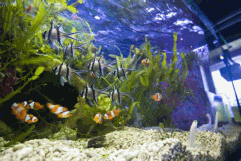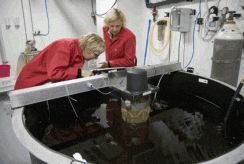Both in Norway and among the international fish-farming community it is well known that copepods are a sort of “vitamin bomb” for fish fry.
Copepods are a type of zooplankton and the nutritional value is regarded as being better than that of rotifers.
At SINTEF Fisheries and Aquaculture in Trondheim two keen scientists, Mr Gunvor Øie and Ms Ingrid Overrein, believe that there is a lot to be learned about the developmental requirements of fish larvae by using copepods, - thinking primarily of cod fry and of new marine species such as groupers and tuna, which are difficult to breed.
The challenge they face has been to automate the processes of harvesting and purification. Large-scale production of fry requires large volumes of copepods. Large tanks are needed to produce sufficient eggs, and since the eggs lie on the bottom, it can also be difficult to harvest them.

Financed by Innovation Norway and Norwegian cod fry breeders, the project has scaled up the size of its tanks, adopted new technology for harvesting eggs and, in the future, will attempt to optimise feeding, water quality and methods of filtering and washing the eggs.
“Every day, we collect eggs from a large 1000-litre tank. We take up an average of eight million eggs a day, and this figure is gradually improving. The challenge lies in improving their quality, so that they will hatch out and develop normally,” says Ms Overrein, who believes that the Trondheim group is well placed in a global context to produce eggs from this species of copepods, which could well be important for the production of marine fish fry in the future.
“We think it is exciting to hear how it is going, every time someone comes in with the chiller bag to pick up fish feed,” smays Mr Øie. “The testing that is done is valuable for us.”
All over the world, aquarists compete to get hold of rare species. The trouble is that there are very few producers. The mandarin is bred only in three or four places in Germany and one in the US. This is due to the fact that the offspring of rare aquarium fish are difficult, not to say quite impossible, to start-feed until they are viable. Many people have tried, but have had to give up.

In Orkanger, a half-hour’s drive from Trondheim, there are tropical treasures that have aroused the interest of aquarists in both Europe and the US. Phrases like “world sensation” and “record” have apparently been used to describe what we are about to see.
Mr Thomas Engels’ day job is as chef at Løkken Shipyard, but at night he is “midwife” to such exotic beauties as mandarins, cardinals, seahorses, the yellowhead jawfish Opistognathus aurifrons and the orange clownfish Amphiprion percula,
Mr Engels is in no doubt that, besides his craft skills, hundreds of hours of work, countless Internet searches, and much trial and error, the special feed he collects from SINTEF is behind the success in his cellar.
Mr Gunvor Øie and Ms Ingrid Overrein also believe in the copepods and in a growing international market. They have already been contacted by a German dealer in aquarium equipment who wants to cover the European market for copepod eggs.
“We want to continue our research in order to find out more about the benefits of copepods as feed for marine fish larvae. Once we have identified the optimal conditions for egg production, it would be natural for an industrial company to take over the production, harvesting, storage and distribution of the eggs,” says Ms Overrein.
“What makes aquarium breeding and the international market so interesting is that we are talking at small quantities that can be sold at high prices. The problems that have to be solved are also identical. Start-feeding cod is quite similar to start-feeding aquarium fish, and the two industries have a great deal to learn from each other,” says Mr Gunvor Øie.

